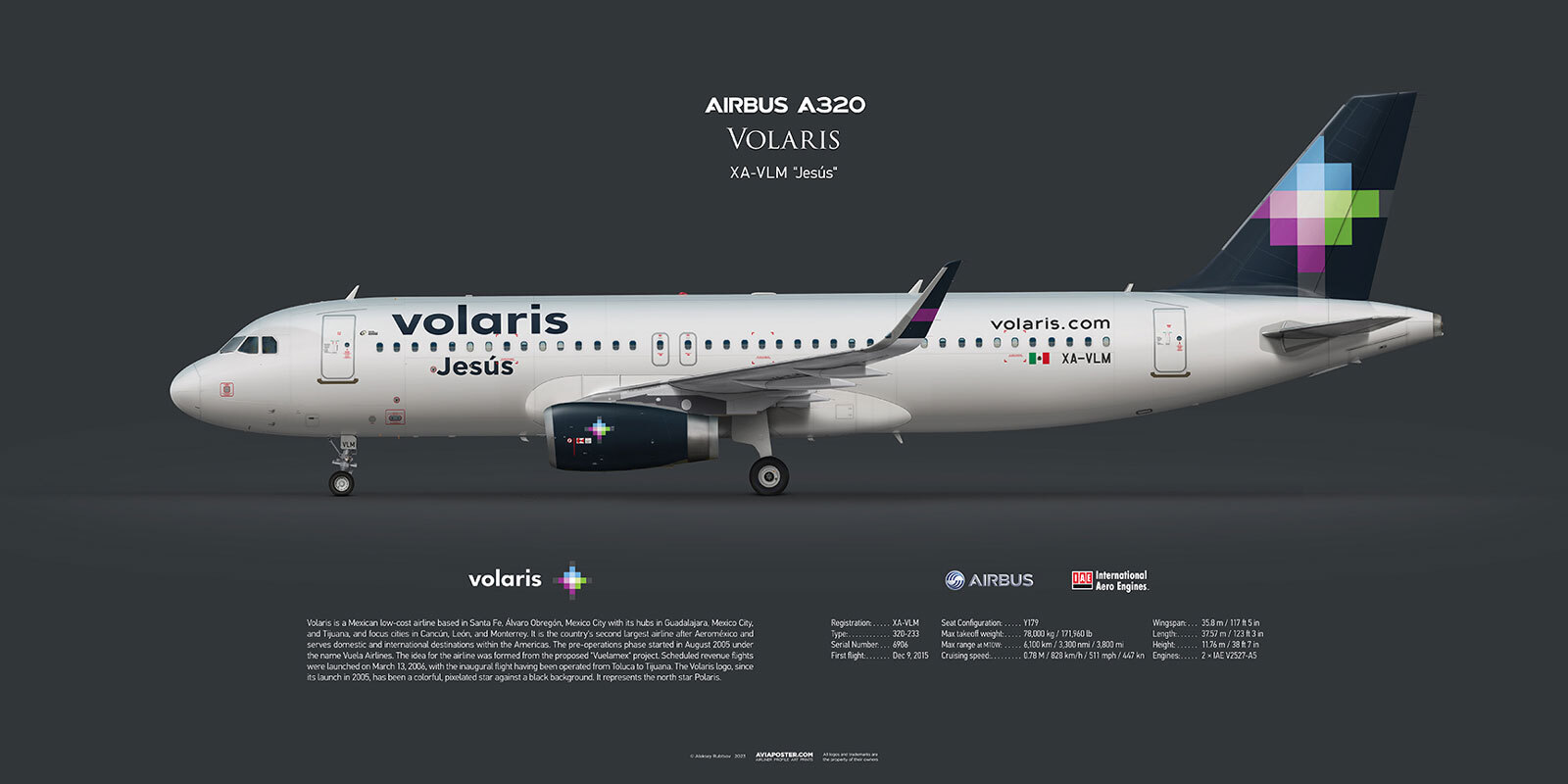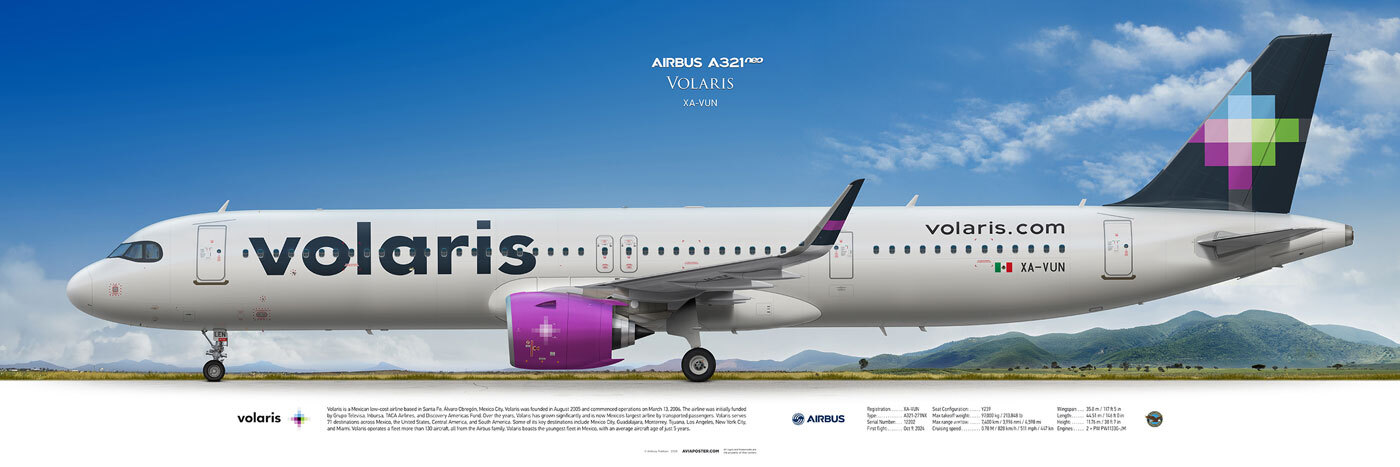The Story of Volaris – Mexico's Ultra-Low-Cost Airline
When it comes to affordable air travel in Mexico, Volaris stands out as a game-changer. Since its inaugural flight in 2006, this ultra-low-cost carrier has revolutionized the way Mexicans and travelers across the Americas perceive air travel. Let's take a closer look at Volaris.
From Concept to Triumph
Volaris took its first literal flight on March 13, 2006, with its inaugural route from Toluca to Tijuana. However, the airline's story began a few years earlier, in 2003, when investment funds Discovery Americas I and Columbia Equity Partners joined forces with TACA Airlines to create a new Mexican airline. What was its mission? The company was called upon to make air travel accessible to the vast majority by maximizing cost reduction. By July 2006, the World Bank's financial arm in Latin America allocated $40 million, increasing the total investment to $130 million, providing a solid foundation for takeoff.
The airline, originally named Vuela Airlines, changed its name to Volaris and quickly gained altitude. In 2010, the company expanded its presence in Mexico City by acquiring routes from now-defunct carriers Aerocalifornia and Mexicana. By 2011, Volaris moved its main hub from Toluca to Guadalajara, strengthening its growth strategy. Today, it is Mexico's largest airline in terms of passenger traffic, having transported over 200 million passengers since its inception. Volaris, whose shares have been listed on the Mexican and New York Stock Exchanges since 2013, demonstrates rapid success.
Travel at Affordable Prices at Your Discretion
Volaris operates under the ULCC (Ultra-Low-Cost Carrier) model, where base fares remain low and additional services are offered for an extra fee. This model is part of the "You Decide" philosophy, aptly reflected in the company's slogan for 2013-2017. Passengers pay only for what they need, whether it's luggage, seat selection, or snacks from the onboard menu "Entre nubes" ("Among the Clouds"). Such personalization allows travelers to reduce expenses to their level of opportunity. The airline ensures maximum flight efficiency on point-to-point routes, avoiding the complexities inherent in traditional carriers.
Volaris boasts one of the youngest fleets in North and South America (the average age of its aircraft is only 6.5 years). This significantly reduces maintenance costs. Add to this additional sources of income, such as the frequent flyer program VClub, which offers discounts on membership fees, and vPass – a subscription to regular mailing newsletters – and you get economical and profitable operations. In fact, Volaris is among the most budget-friendly airlines in the world, confirming the high rationality of this approach.
Connecting North and South America
Volaris aircraft operate within Mexico and beyond, serving flights from hubs in Guadalajara, Mexico City, and Tijuana, as well as from the country's largest cities. Domestically, they serve over 35 destinations, ranging from tourist centers like Cancun and Los Cabos to vibrant cities such as Monterrey. Internationally, the company connects Mexico with major hubs and popular resorts in the USA (Los Angeles, Chicago, and Miami), as well as gems of Central America like Guatemala City, San Salvador, and San José in Costa Rica.
Since 2023, Volaris has been operating more than 300 daily flights across 231 routes. Choosing this company's services is an excellent solution for budget-conscious travelers. The codeshare agreement with Frontier Airlines, launched in 2018, further expands options for cross-border travelers by enabling seamless connecting flights on a single ticket. Whether you're flying north in search of snowy plains or south as a beach holiday enthusiast, Volaris has you covered.
From Humble Beginnings to Modern Marvels
Volaris started its operations in 2006 with just four Airbus A319 aircraft, a modest beginning for an airline with big ambitions. Over the years, its fleet grew and expanded, relying exclusively on the Airbus A320 family for operational efficiency. Historically, early stages of its operations were dominated by A319 and A320 models, which proved their reliability and efficiency on domestic routes.
Today, Volaris boasts a modern fleet of 137 aircraft (as of February 2025), comprising A319, A320, A320neo, A321, and A321neo models. In 2016, Volaris became the first North American airline to operate the A320neo.
Volaris ranks among the top 20 safest low-cost airlines globally, according to AirlineRatings.com. This is made possible by the company's relatively young fleet and the stringent safety standards it adheres to meticulously.
When it comes to affordable air travel in Mexico, Volaris stands out as a game-changer. Since its inaugural flight in 2006, this ultra-low-cost carrier has revolutionized the way Mexicans and travelers across the Americas perceive air travel. Let's take a closer look at Volaris.
From Concept to Triumph
Volaris took its first literal flight on March 13, 2006, with its inaugural route from Toluca to Tijuana. However, the airline's story began a few years earlier, in 2003, when investment funds Discovery Americas I and Columbia Equity Partners joined forces with TACA Airlines to create a new Mexican airline. What was its mission? The company was called upon to make air travel accessible to the vast majority by maximizing cost reduction. By July 2006, the World Bank's financial arm in Latin America allocated $40 million, increasing the total investment to $130 million, providing a solid foundation for takeoff.
The airline, originally named Vuela Airlines, changed its name to Volaris and quickly gained altitude. In 2010, the company expanded its presence in Mexico City by acquiring routes from now-defunct carriers Aerocalifornia and Mexicana. By 2011, Volaris moved its main hub from Toluca to Guadalajara, strengthening its growth strategy. Today, it is Mexico's largest airline in terms of passenger traffic, having transported over 200 million passengers since its inception. Volaris, whose shares have been listed on the Mexican and New York Stock Exchanges since 2013, demonstrates rapid success.
Travel at Affordable Prices at Your Discretion
Volaris operates under the ULCC (Ultra-Low-Cost Carrier) model, where base fares remain low and additional services are offered for an extra fee. This model is part of the "You Decide" philosophy, aptly reflected in the company's slogan for 2013-2017. Passengers pay only for what they need, whether it's luggage, seat selection, or snacks from the onboard menu "Entre nubes" ("Among the Clouds"). Such personalization allows travelers to reduce expenses to their level of opportunity. The airline ensures maximum flight efficiency on point-to-point routes, avoiding the complexities inherent in traditional carriers.
Volaris boasts one of the youngest fleets in North and South America (the average age of its aircraft is only 6.5 years). This significantly reduces maintenance costs. Add to this additional sources of income, such as the frequent flyer program VClub, which offers discounts on membership fees, and vPass – a subscription to regular mailing newsletters – and you get economical and profitable operations. In fact, Volaris is among the most budget-friendly airlines in the world, confirming the high rationality of this approach.
Connecting North and South America
Volaris aircraft operate within Mexico and beyond, serving flights from hubs in Guadalajara, Mexico City, and Tijuana, as well as from the country's largest cities. Domestically, they serve over 35 destinations, ranging from tourist centers like Cancun and Los Cabos to vibrant cities such as Monterrey. Internationally, the company connects Mexico with major hubs and popular resorts in the USA (Los Angeles, Chicago, and Miami), as well as gems of Central America like Guatemala City, San Salvador, and San José in Costa Rica.
Since 2023, Volaris has been operating more than 300 daily flights across 231 routes. Choosing this company's services is an excellent solution for budget-conscious travelers. The codeshare agreement with Frontier Airlines, launched in 2018, further expands options for cross-border travelers by enabling seamless connecting flights on a single ticket. Whether you're flying north in search of snowy plains or south as a beach holiday enthusiast, Volaris has you covered.
From Humble Beginnings to Modern Marvels
Volaris started its operations in 2006 with just four Airbus A319 aircraft, a modest beginning for an airline with big ambitions. Over the years, its fleet grew and expanded, relying exclusively on the Airbus A320 family for operational efficiency. Historically, early stages of its operations were dominated by A319 and A320 models, which proved their reliability and efficiency on domestic routes.
Today, Volaris boasts a modern fleet of 137 aircraft (as of February 2025), comprising A319, A320, A320neo, A321, and A321neo models. In 2016, Volaris became the first North American airline to operate the A320neo.
Volaris ranks among the top 20 safest low-cost airlines globally, according to AirlineRatings.com. This is made possible by the company's relatively young fleet and the stringent safety standards it adheres to meticulously.

A Bright Star: Volaris' brand identity is as bold as its business model.
Wikipedia and other online sources claim that the name of the Mexican airline Volaris originates from the word Polaris (the North Star). This is confirmed by the company's logo – a multi-colored star with blurred edges on a black background, paying homage to Alpha Ursae Minoris. However, numerous sources somehow overlook the fact that the name Volaris distinctly incorporates the word Volare (Spanish for "I Fly"). And remember that catchy song that was popular on radio stations at one point:
Volare, oh oh
Cantare, oh oh oh oh...
(I Flying and singing...)
The airline's branding extends to its fleet, where many aircraft have been given personal names. Sometimes it's a person's name (like "Samuel" or "Luisa") or a family name ("Los Capistrán"), and sometimes even a new destination ("Guatemala"). This unique touch gives Volaris' fleet a special personality.
In Conclusion...
Volaris is more than just an airline. It's a movement that has opened up the skies for many people in Mexico and beyond. From its modest start in 2006 to becoming a regional leader, Volaris combines affordability, efficiency, and a personalized approach. Whether you're flying to a beach or a boardroom, Volaris offers a journey that is as vibrant as it is practical. So next time you see that pixelated star, you'll remember its story and perhaps even spot your name on the side of a plane.
Wikipedia and other online sources claim that the name of the Mexican airline Volaris originates from the word Polaris (the North Star). This is confirmed by the company's logo – a multi-colored star with blurred edges on a black background, paying homage to Alpha Ursae Minoris. However, numerous sources somehow overlook the fact that the name Volaris distinctly incorporates the word Volare (Spanish for "I Fly"). And remember that catchy song that was popular on radio stations at one point:
Volare, oh oh
Cantare, oh oh oh oh...
(I Flying and singing...)
The airline's branding extends to its fleet, where many aircraft have been given personal names. Sometimes it's a person's name (like "Samuel" or "Luisa") or a family name ("Los Capistrán"), and sometimes even a new destination ("Guatemala"). This unique touch gives Volaris' fleet a special personality.
In Conclusion...
Volaris is more than just an airline. It's a movement that has opened up the skies for many people in Mexico and beyond. From its modest start in 2006 to becoming a regional leader, Volaris combines affordability, efficiency, and a personalized approach. Whether you're flying to a beach or a boardroom, Volaris offers a journey that is as vibrant as it is practical. So next time you see that pixelated star, you'll remember its story and perhaps even spot your name on the side of a plane.
